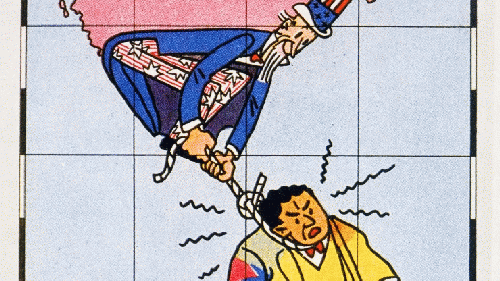
US Still Sees Latin America as its back yard
(Image by medium.com/s/story/timeline-us-intervention-central-america-a9bea9ebc148) Details DMCA
During the 21st century, the US, working with corporate elites, traditional oligarchies, military, and corporate media, has continually attempted coups against Latin American governments that place the needs of their people over US corporate interests. US-organized coups in Latin American countries is hardly a 20th-century phenomenon.
However, this century the US rulers have turned to a new coup strategy, relying on soft coups, a significant change from the notoriously brutal military hard coups in Chile, Argentina, Uruguay, and other countries in the 1970s. One central US concern in these new coups has been to maintain a legal and democratic faà �ade as much as possible.
The US superpower recognizes that successful soft coups depend on mobilizing popular forces in anti-government marches and protests. Gene Sharp-style color revolutions are heavily funded by US and European NGOs, such as USAID, NED, National Democratic Institute, International Republican Institute, Open Society Foundations, Ford Foundation, and others. They make use of organizations professing "human rights" (such as Human Rights Watch, Amnesty International), local dissident organizations, and increasingly, liberal-left media (even Democracy Now) to prepare the groundwork.
US regime-change operations have found three mechanisms this century that have been tremendously successful. First, economic warfare on a country, through sanctions and outright blockades, creates rising discontent against the targeted government. Second, increasing use of corporate media and social media to spread disinformation (often around "human rights," "democracy," "freedom," or "corruption") to foment mass movements against leaders that prioritize their nation's development over US financial interests. This heavily relies on CIA social-media operations to blanket a country with disinformation. Third, lawfare, using the appearance of democratic legality to bring down those defending their country's national sovereignty. Related to lawfare are the electoral coups in countries such as Haiti, Honduras, and Brazil, where the US engineers or helps to engineer a coup by stealing the election.
US-Backed Coups and Attempted Coups
2001 Haiti. Haitian paramilitaries based in the Dominican Republic launched an attack on the National Palace, seat of the government of President Aristide. The attack failed, but until 2004, similar to the 1980s Nicaraguan contras, these paramilitaries launched numerous raids into Haiti, and played a key role leading to the 2004 coup perpetrated directly by US troops.
2002 Venezuela. The US government partially funded and backed the short-lived April 11-14 coup against Hugo Chavez.
2002-3 Venezuela. Management of the state oil company PDVSA organized an "oil strike," actually a lockout of the oil workers, to drive Hugo Chavez out of power. This again failed in early 2003.
2003 Cuba. In the lead-up to the March 2003 US invasion of Iraq, John Bolton claimed Cuba was a state sponsor of terrorism, producing biological weapons for terrorist purposes, just as Saddam's Iraq was falsely claimed to have weapons of mass destruction (WMDs). During this period, the US increased its anti-Cuba propaganda directed at the country and increased funding to "pro-democracy" groups in Cuba, while anti-Cuban right-wing groups escalated their activities. The US paid "dissident" groups to organize protests and disruptions, including hijacking seven boats and airplanes to reach the US where they were never prosecuted. The goal was to create the appearance of disorder in Cuba, which, combined with its alleged biological WMDs, demanded an international intervention to restore order. Cuba squashed this movement in spring 2003.
2004 Haiti. In an early 20th-century-style US coup, US troops invaded Haiti, kidnapped President Jean Bertrande Aristide, and exiled him to the Central African Republic.
2008 Bolivia. The Media Luna attempted coup involved right-wing leaders and some indigenous groups from Bolivia's lowlands financed by the US. They sought to separate the richer Media Luna region from the rest of the country. In the process, they killed 20 supporters of President Evo Morales. Juan Ramon Quintana of the Bolivian government reported that between 2007-2015, the NED gave $10 million in funding to some 40 institutions including economic and social centers, foundations and NGOs. US embassy cables showed it sought to turn social and indigenous movements against the Evo Morales government.
2009 Honduras. Honduran military forces, under orders from the US, seized President Manuel Zelaya, brought him to the US military base at Palmerola, then exiled him to Costa Rica. This began an era of brutal neoliberal narco-trafficking regimes that ended in 2021 with the landslide election of Xiomara Castro, Zelaya's wife.
2010 Ecuador. In September a failed coup against President Rafael Correa by military and police units backed by the indigenous organizations CONAIE and Pachakutik. The US had infiltrated the police and armed forces, while the NED and USAID funded these indigenous organizations.
2011 Haiti. Following the Haiti earthquake in 2010 that killed 200,000, Secretary of State Hillary Clinton imposed Michel Martelly as president after threatening to cut off US aid to Haiti. Clinton flew to Haiti to demand that Martelly be named one of the two runoff candidates, although Martelly was not recognized by the Electoral Council as one of the qualifiers. Despite a voter boycott, with fewer than 20% of the electorate voting, Martelly was announced the winner of the "runoff." One reason why most Haitians boycotted was that the most popular political party in the country, Fanmi Lavalas, the party of former President Jean-Bertrand Aristide, was excluded from the ballot. The Haiti elections were funded by USAID, Canada, the OAS, the European Union and other foreign bodies.
(Note: You can view every article as one long page if you sign up as an Advocate Member, or higher).





